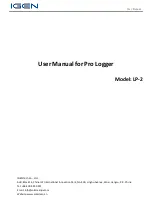
If the user uses any of the flow and sensor units, the "Sensor Factor
" will need to be informed. If none of the available units are required, the "Unit
Factor" needs to be
calculated by relating the "Unit" parameter, and filling it in so that the device correctly converts pulses to the required unit. In
th
is case,
LogBox 3G
will convert the pulses to the user-defined unit as follows:
● User Value
= ((Count)/(Sensor Factor))*(Unit Factor)
○ It is not necessary to consider the records interval for calculations.
Fig. 02
– Digital Input Screen
If the user wants to vi
ew the deviceion of parts in "parts per minute", for example, and the application has a PNP type sensor that calculates one
part produced for every 30 rising edge pulses, the following p
arameters must be configured at the device’s digital input:
•
Input Type:
Pulse Count.
•
Sensor Type:
PNP.
•
Countin Edge:
Rise.
•
Application:
Flow Rate.
•
Sensor Factor:
30 (pulses/part).
It is necessary to select the
Average Flow by Acquisition Interval
option and fill in the following parameters:
•
Unit:
Customized.
•
Unit Factor:
60 (conversion from parts per second to parts per minute).
It is also possible to select the
Volume Sinse Last Reset
option and fill in the following parameters:
•
Unit:
Customized.
•
Sensor Factor:
1 (stores the cumulative number of parts).
LogBox 3G
will thus record the number of pulses occurring within that period at each logging interval, and every time the data is displayed, it will
transform the pulses into the number of parts produced per minute (user-customized unit).
In the same example, the logging interval can be assumed to be 20 seconds. As such, if the sensor gives 20 pulses per second,
LogBox 3
G
will
record 400 pulses per interval, displaying 40 parts per minute (((20 pulses/s)/(30 pulses/part)) * 60 (1 min) = 40).
5.2.2 EVENT LOG
If the digital input is configured in "Event Logging" mode, each selected edge will create a record in the memory, reporting the event and the instant
that it occurred. This log will not be synchronized with the periodic logs, but will respect the start and end log modes. Events will be logged after the
configured debounce time expires. Events will be thus logged with the debounce time delay.
LogBox 3G
can log up to 10 events in 10 seconds.
In addition to logging aperiodic events,
LogBox 3G
can also be configured to periodically record the digital input value. As such, in the logging
interval, the device will record whether the digital input is at logical level ‘1’ or at logical level ‘0’. This is useful for providing graphic monitoring of the
digital input status along with the analog channels.
In
NOVUS Cloud
,
LogBox 3G
will publish aperiodic events in a table containing the event timestamp and the logical level at the time of the event.
The publication of all events recorded in the memory can thus be ensured. However, these events cannot be shown in graphic format via
NOVUS
Cloud
. To do so, the device needs to be configured to log the status of the digital input periodically, along with the analog channels. As such, the
status of the digital input can be monitored graphically at the logging frequency.
5.2.3 LOG CONTROL
The digital input can be used to start and/or pause the logs from the other input channels. Once configured in "Log Control" mode, each selected
edge will start or stop the logging in memory process. As in the "Event Logging" mode, there will only be action related to detected events after the
configured debounce time expires. As such, logs will be started/paused with the debounce time delay.
20/66
















































